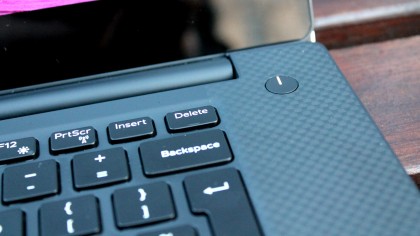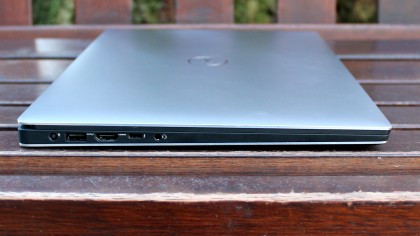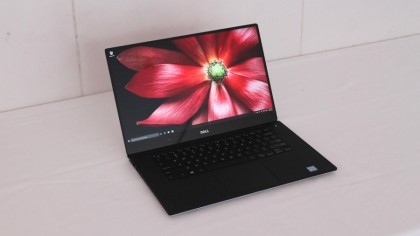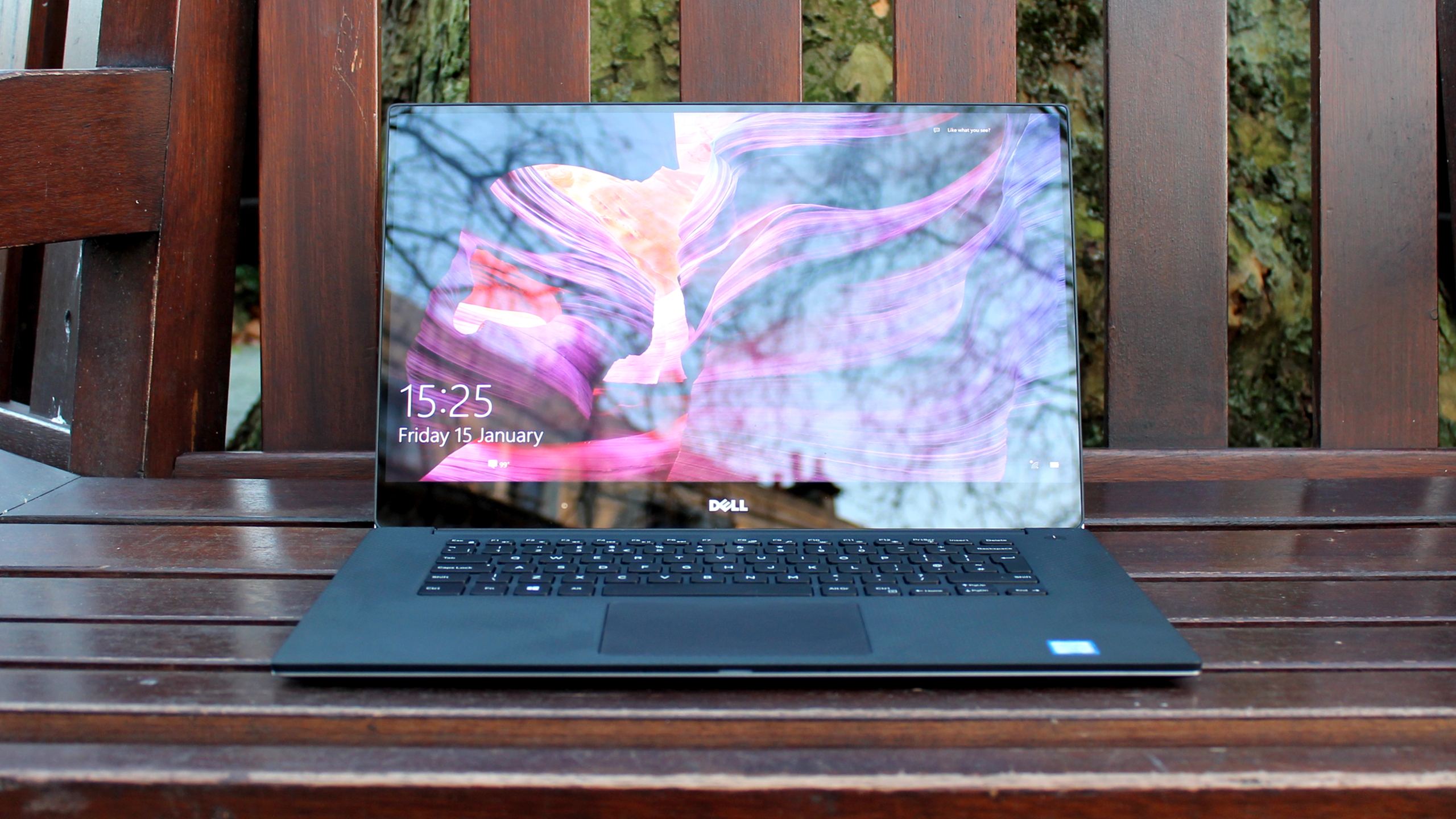Why you can trust TechRadar
The XPS 15 is loaded with high-quality components, including Intel's latest sixth-generation Skylake processor and an Nvidia GTX 960M GPU. That dedicated graphics chip places the XPS 15 in unusual territory.
Dell isn't marketing the XPS 15 as a gaming device, but it's powerful enough to handle most modern titles on high graphics settings with the resolution set to 1,920 x 1,080. Again, it's here that the XPS 15's color-rich, accurate display really shines.
Whether I was smashing skulls against Mortal Kombat X's vibrant and detailed backdrops, driving around the streets of Los Santos in GTA V or playing a frenzied match in Rocket League, I was constantly in awe of just how the display brought the game's colors to life. Where the XPS 15 managed to run games at the golden 60 frames per second (fps) mark with the graphical details ramped up, it was the best experience I've ever had on a 1080p laptop, period.

And when it didn't hit 60 fps? Not so good.
The 960M sits pretty as a mid-range mobile GPU in Nvidia's lineup, and its limiting 2GB of virtual memory means it's ill-equipped to handle texture heavy games, such as Fallout 4 and The Witcher 3, without suffering serious frame rate dips in busy scenes. In Fallout, for example, I had to lower the resolution to 1,366 x 768 and the graphical details to minimum to hit a consistent 60fps.
If that sort of experience is likely to frustrate you, skip the XPS 15 and hunt down a gaming laptop with a GTX 970M, the Aorus X3 Plus v3, which has a similarly sleek chassis, thin display bezels and a whopping 6GB of video memory for roughly the same cost.
Benchmarks
Here's how the Dell XPS 15 performed in our suite of benchmark tests:
- 3DMark: Cloud Gate: 16,942; Sky Diver: 12,541; Fire Strike: 3,930
- Cinebench R15 CPU: 679cb; Graphics: 69.46 fps
- GeekBench: 3,248 (single-core); 12,449 (multi-core)
- PCMark 8 (Home Test): 3,424 points
- PCMark 8 Battery Life: 1 hour and 52 minutes
- Middle Earth: Shadow of Mordor (1080p, Ultra): 298.66 fps; (1080p, Low): 66.13 fps
- Metro: Last Light (1080p, Ultra): 58 fps; (1080p, Low): 118 fps
Let's remind ourselves of how Dell's XPS 15 from 2015 fared. The older model features a fourth-generation Intel Core i7-4712HQ Haswell processor, clocked at 3.3GHz, and an Nvidia GeForce GT750M GPU with 2GB of GDDR5 video memory.
- 3DMark: Cloud Gate: 10,408; Sky Diver: 6,866; Fire Strike: 2,060
- Cinebench R15 CPU: 595cb points; Graphics: 72.05 fps
- PCMark 8 (Home Test): 2,571 points
- PCMark 8 Battery Life balanced 50% screen: 3 hours 30 mins
Unsurprisingly, the new XPS 15 beats last year's incarnation in every area, notching a 29% higher score in PCMark 8's Home Test and 13% higher in Cinebench R15's CPU test. The Intel Core i7-6700HQ Skylake chip inside has a thermal design power rating (TDP) of 45 Watts and is one of the beefiest processors around.
As expected, it outperforms the fourth-generation Intel Core i7-4720HQ Haswell chip in the Asus UX501, achieving a 28% higher score in PCMark 8's Home Test. It also easily beats the dual-core i5-6300U processor in the Surface Book, achieving a 38% higher score in same the benchmark.
Processor performance is identical to gaming laptops, such as the Origin EVO15-S, which feature the same CPU. Origin's machine scored 3,416 points, versus the XPS 15's 3,424 points. If you regularly edit video, work with complex spreadsheets or 3D rendering programs, the XPS 15 offers the most processing grunt available in a machine with a compact chassis.
It all adds up to a laptop that excels at everyday computing tasks, whether that's surfing the internet with 30 or more tabs open in multiple browsers, editing big image or video files, typing up documents in Office 2016 or streaming content in Ultra HD. Having 16GB of RAM under the hood, along with a fast 512GB SSD, means you never have to wait for apps to open or endure long loading times when playing games.

Longevity is lacking
The one area where the XPS 15 performs badly is battery life, and even a Skylake chip inside can't do much to prevent the laptop's bright 4K display from draining power quickly. The XPS 15 lasted for just 1 hour and 52 minutes in PCMark 8's punishing battery life test, which is what you can expect when you're pushing the machine to its limits.
It fared much better under real world use – typing up documents, watching YouTube videos and occasional bouts of Battlefield 4 and Rocket League – lasting around 3 hours and 30 minutes with the brightness lowered to 75%. Even so, it doesn't make the XPS 15 a laptop you'll want to take on a trip if power sockets will be in short supply.
Nixing the number pad
Sorry, accountants: Dell has spaced out the XPS 15's chiclet-style keys to kept the keyboard's layout centred, leaving no room for a number pad. The keyboard's response is underwhelming due to its low amount of key travel, so if you're expecting a greater amount of tactile feedback then prepare for disappointment.
Though fine for general use, this keyboard lacks the tactile and comfortable typing action that you'll find on other devices, such as Dell's own XPS 12 and the Lenovo Yoga 260. The next XPS 15 has to address this if it wants to be taken seriously as a productivity machine.

I had a brief problem with the XPS15's space bar, which suffers from an irritating squeaking sound. In one instance, it came stuck and refused to pop back out again, something that was eventually fixed by pressing down on it harder. I've also been unsuccessful in my attempts to keep the keyboard backlight to remain on permanently, despite pressing the appropriate function key combination and setting it in the BIOS to remain on. Dell is currently investigating whether that's a one-off issue related to my product sample.
Trackpad and tweeters
The XPS 15's roomy clickpad is the best I've ever used on a Windows laptop, and is almost as smooth and responsive to use as the ones Apple uses on its MacBooks. It's even possible to use three-finger gestures smoothly in Windows 10. The experience isn't quite as fluid as what you'll get on OS X El Capitan (palm rejection is worse for a start), but Microsoft and its partners are catching up in this area.
But the XPS 15's speakers are disappointing, to put it mildly. Dell made the strange decision of placing the laptop's two stereo speakers on the underside of the machine, making the already muddy tones even more difficult to make out.
Dell attempts to gloss over the XPS 15's poor speakers using the Waves MaxxAudio app, which artificially enhances the sound by manipulating bass, mid-range and treble tones through a software equalizer to poor effect. When the speakers on Apple's 12-inch MacBook outshine those on a much thicker 15-inch laptop, it's time to go back to the drawing board.

